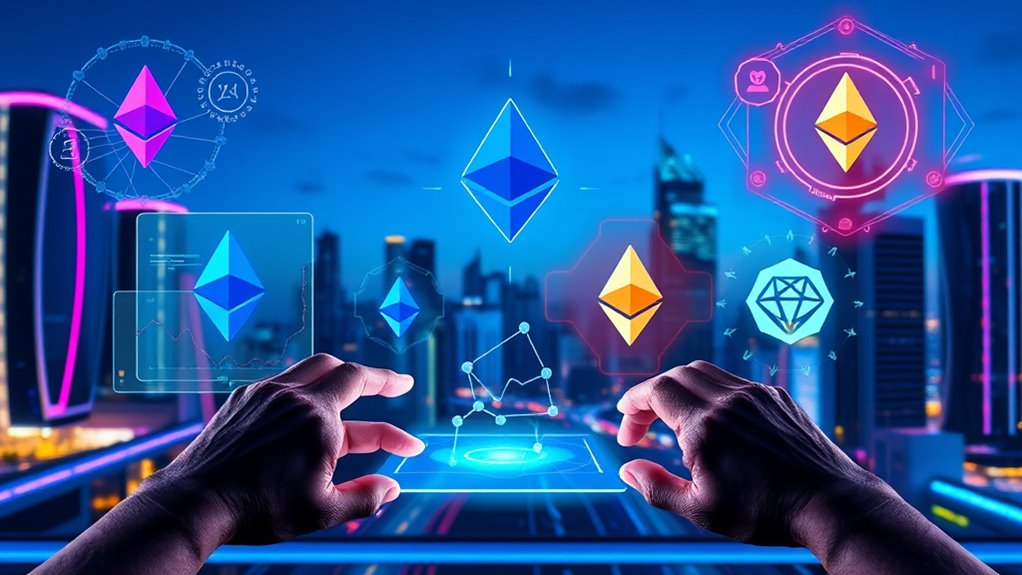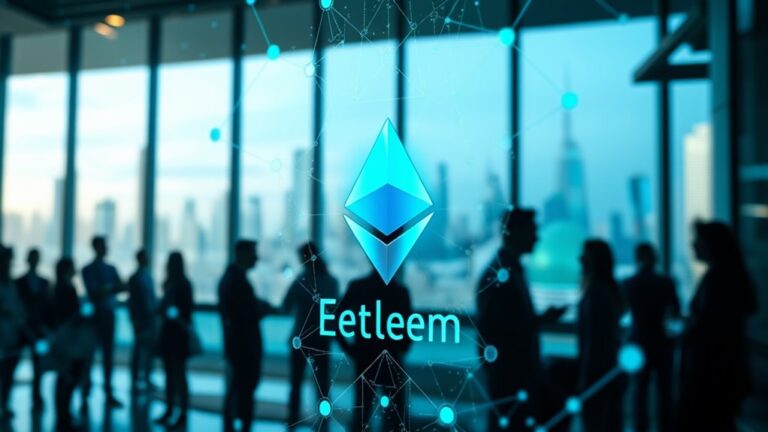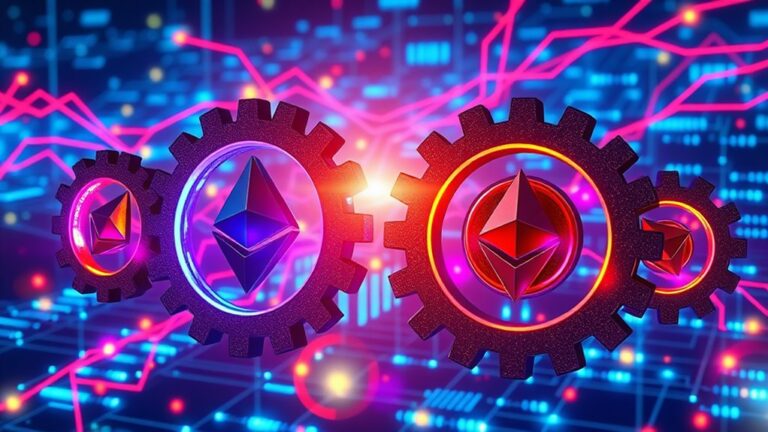
Ethereum Dapps: Unlocking the Top Decentralized Applications Today
Ethereum dApps revolutionize traditional applications through decentralized architecture, eliminating single points of failure. These blockchain-based applications leverage smart contracts for autonomous execution without intermediaries across various industries. Leading examples include Uniswap for decentralized trading, MetaMask for Web3 access, and Axie Infinity’s play-to-earn gaming model. Built with Solidity and supported by development frameworks like Truffle, dApps require compatible wallets for interaction. Future developments include AI integration and Layer 2 solutions for enhanced functionality and scalability.
Key Takeaways
- Ethereum’s decentralized applications like Uniswap revolutionize finance with automated market makers eliminating intermediaries.
- MetaMask serves as the essential gateway to Web3, providing secure wallet management for interacting with Ethereum dApps.
- Smart contracts written in Solidity enable self-executing code on the Ethereum Virtual Machine, powering autonomous applications.
- Axie Infinity transforms gaming through NFT-based play-to-earn models, creating new economic opportunities for players.
- Layer 2 solutions are addressing Ethereum’s scalability challenges with faster transactions and reduced costs for dApp users.
What Makes Ethereum DApps Revolutionary in the Crypto Space

While traditional applications rely on centralized servers and authorities, Ethereum decentralized applications (DApps) represent a fundamental shift in how digital platforms operate. These applications run on a distributed network of computers rather than a single server, eliminating single points of failure and enhancing security.
At their core, Ethereum DApps operate autonomously through smart contracts that execute automatically when predetermined conditions are met. This removes the need for intermediaries while increasing transparency, as all transactions are recorded on the public blockchain.
The revolutionary aspect of DApps extends beyond their technical architecture to their community-focused development model. By enabling new revenue streams through tokenization and creating censorship-resistant platforms where users maintain control of their data, Ethereum DApps are transforming industries from finance to gaming. This transformation is supported by Ethereum’s transition to a proof-of-stake consensus mechanism, which enhances efficiency and sustainability across its network.
Top 5 Ethereum DApps Transforming Industries Today

As Ethereum continues to mature as a blockchain platform, several decentralized applications have emerged as industry leaders, demonstrating the practical utility of blockchain technology beyond theoretical concepts.
Uniswap leads as a pioneering decentralized exchange, enabling direct token trading through its innovative automated market maker model.
Revolutionizing DeFi through peer-to-peer trading protocols that eliminate traditional intermediaries.
MetaMask functions as the essential gateway to Web3, providing users with secure key management and dApp interaction capabilities.
Axie Infinity has revolutionized gaming by integrating NFTs and creating economic opportunities through its play-to-earn model.
Chainlink bridges the gap between blockchain and real-world data as a decentralized oracle network, supporting over $20 trillion in transaction volume.
These DApps exemplify the interconnectivity and composability that defines the Ethereum ecosystem, allowing for innovative solutions across various industries.
Each of these applications represents significant advancement in their respective sectors, showcasing Ethereum’s versatility across financial services, gaming, and data infrastructure.
Key Features That Power Successful Ethereum Applications

The foundation of effective Ethereum applications rests on several key technical components working in harmony. Smart contracts written in Solidity form the core, enabling self-executing, immutable code that operates on the Ethereum Virtual Machine (EVM). These contracts provide transparency and security through their open-source nature.
Development frameworks like Truffle, Hardhat, and Remix IDE streamline the building and testing processes. Web3.js bridges the gap between frontend interfaces and blockchain functionality, allowing users to interact with applications through wallet integration.
The decentralized architecture eliminates single points of failure while providing transparency through blockchain technology. Successful Ethereum applications leverage Proof of Stake consensus mechanisms and deterministic execution to guarantee consistent performance. This transition to Proof of Stake enhances the efficiency of these applications by significantly reducing energy consumption and promoting stability.
Their user interfaces typically employ modern frameworks like React while minimizing personal data requirements, enhancing both privacy and cost efficiency.
Essential Wallets for Seamless DApp Interaction

Every successful interaction with Ethereum decentralized applications requires a compatible wallet that serves as the gateway between users and blockchain functionality.
These wallets come in various forms, including hot wallets for frequent transactions and cold wallets for secure storage.
Ethereum wallet diversity offers tailored security options for every user’s blockchain interaction needs.
Popular options like MetaMask, Trust Wallet, and MyEtherWallet offer extensive dApp support and intuitive interfaces.
Hardware solutions such as Ledger Nano provide enhanced security for users concerned about asset protection.
When selecting a wallet, users should consider their specific needs, security requirements, and dApp compatibility.
The best wallets prioritize user security while offering seamless dApp integration, multi-platform availability, and support for ETH and ERC-20 tokens.
This combination of features guarantees efficient transactions and an improved overall user experience when maneuvering through the Ethereum ecosystem. Additionally, understanding the types of Ethereum wallets is crucial for making an informed decision that aligns with individual usage patterns.
Future Trends Shaping the Ethereum DApp Ecosystem

Emerging technologies continue to revolutionize the Ethereum ecosystem, creating unprecedented opportunities for decentralized application development. Smart contracts are becoming more sophisticated, integrating AI capabilities and expanding across finance, gaming, and real estate sectors. Meanwhile, Layer 2 solutions like Polygon address vital scalability challenges. Layer 2 solutions enhance Ethereum’s capacity to support a growing number of decentralized applications (dApps) and users more efficiently.
| Trend | Impact | Timeline |
|---|---|---|
| Smart Contract Evolution | Enhanced functionality, AI integration | 2024-2025 |
| Layer 2 Solutions | Improved transaction speed, lower costs | Current |
| Cross-Chain Interoperability | Seamless asset transfer between blockchains | Developing |
| AI Integration | Automated decision-making, improved security | Emerging |
As these technologies mature, developers face regulatory challenges while benefiting from increased security through zero-knowledge proofs and multi-signature authentication. The intersection of AI with blockchain particularly promises to transform how dApps function, enabling real-time data processing while maintaining decentralization principles.
Frequently Asked Questions
How Profitable Is Developing an Ethereum DAPP Compared to Traditional Apps?
Developing Ethereum DApps can be more profitable than traditional apps due to growing market potential ($139.6 billion by 2032) and token economics, despite higher development costs and regulatory uncertainties.
What Programming Languages Are Required to Build Ethereum DAPPS?
Building Ethereum dapps typically requires Solidity for smart contracts, JavaScript (with frameworks like React) for front-end development, and tools like Web3.js or Ethers.js to connect the application with the blockchain.
How Do Gas Fees Impact DAPP User Experience?
Gas fees create astronomically frustrating barriers for dapp users. They increase transaction costs, complicate the user experience, deter small-value transactions, and cause delays during network congestion, greatly affecting adoption and accessibility of decentralized applications.
Can DAPPS Function During Ethereum Network Congestion or Outages?
DApps can function during network congestion but experience slower transaction confirmations and higher fees. During extreme congestion, user experience degrades considerably. Complete network outages are rare, but DApps retain their decentralized architecture regardless.
What Legal Challenges Do DAPP Developers Face Across Different Jurisdictions?
Verily, dApp developers navigate a legal labyrinth across jurisdictions, confronting securities law compliance, varying regulatory frameworks, KYC/AML requirements, data privacy obligations, and smart contract enforceability challenges. This regulatory patchwork necessitates jurisdiction-specific compliance strategies.
Conclusion
Ethereum DApps continue to revolutionize industries through blockchain innovation and decentralized governance. Consider Uniswap, which processed over $1 trillion in trading volume without traditional intermediaries, demonstrating the practical impact of this technology. As development tools improve and layer-2 solutions address scalability concerns, these applications will likely become more accessible to everyday users, potentially reshaping our digital interactions in finance, gaming, and beyond.












